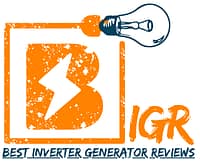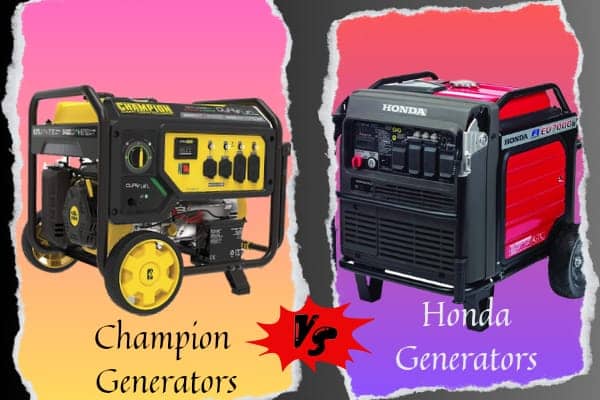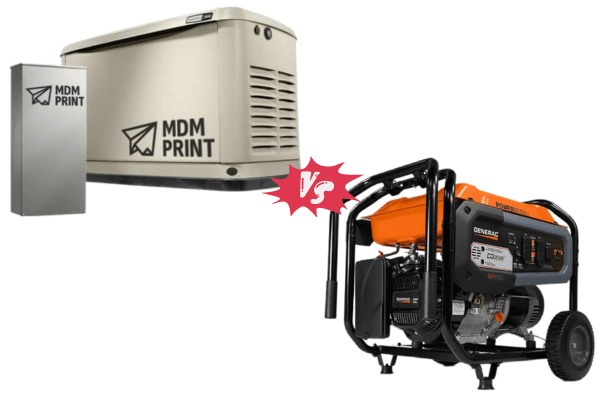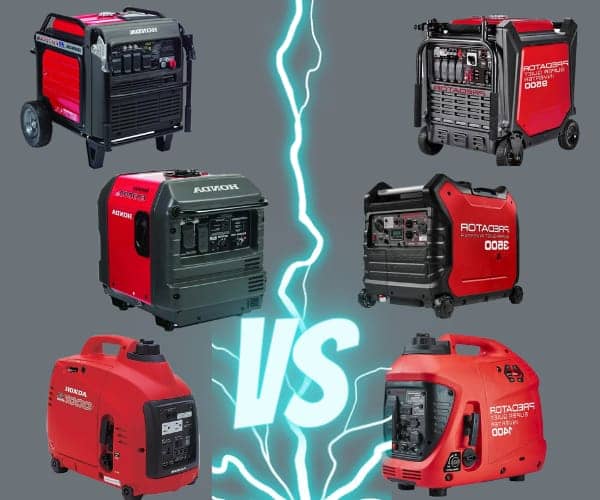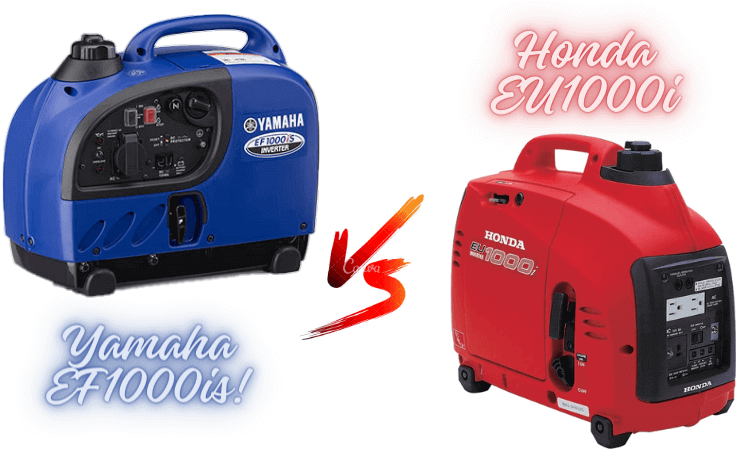
Have you found yourself in a power-sapping predicament and need a trusty generator to come to your rescue? Well, look no further than the Yamaha EF1000iS and Honda EU1000i – two of the top dogs in portable power.
As someone who’s relied on generators in more than one emergency situation, I can tell you these compact workhorses from Yamaha EF1000iS vs. Honda EU1000i are worth their weight in gold when the lights go out. But which one should you call upon to charge your cellphone, keep the fridge running or power your tools?
That’s what we’re here to compare. I’ve spent plenty of late nights with each of these 1,000-watt generators and have some valuable insights to share. From runtime to noise level to overall usability, we’ll break down the key specs so you can determine which brand is the best match for your needs.
By the end, you’ll have a full understanding of these top portable power players’ strengths and weaknesses. So grab a flashlight – we’re diving into the face-off between Yamaha and Honda’s champion generators! Buckle up as I shed some light on these little powerhouses and help you pick a winner.
Complete Overview of Yamaha EF1000iS vs. Honda EU1000i
| Feature | Yamaha EF1000iS | Honda EU1000i |
| Engine Type | 4-stroke, single-cylinder, air-cooled | 4-stroke, single-cylinder, air-cooled |
| Engine Displacement | 50cc | 49.4cc |
| Output Power | 900 watts (continuous), 1000 watts (max) | 900 watts (continuous), 1000 watts (max) |
| Voltage | 120V AC | 120V AC |
| Frequency | 60 Hz | 60 Hz |
| Fuel Tank Capacity | 2.5L gallons | 2.3L gallons |
| Runtime at 25% Load | Approximately 12 hours | Approximately 8.7 hours |
| Noise Level (25% Load) | 47 dBA | 53 dBA |
| Weight | 27.9 lbs | 29 lbs |
| Fuel Type | Unleaded gasoline | Unleaded gasoline |
| Oil Capacity | 0.42 quarts | 0.37 quarts |
| Starting Mechanism | Recoil | Recoil |
| Parallel Capability | Yes (with parallel kit) | Yes (with parallel kit) |
| Outlets | 2 x 120V AC outlets, 8A DC outlet | 2 x 120V AC outlets, 8A DC outlet |
| Inverter Technology | Yes | Yes |
| Fuel Gauge | Yes | No |
| Oil Watch Warning System | Yes | Yes |
| Eco-Throttle System | Yes | Yes |
| Dimensions (L x W x H) | 17.7 x 9.4 x 14.9 inches | 17.8 x 9.5 x 15 inches |
| Warranty | 3 years | 3 years |
Comparing in power output
When it comes to power output, these two portable generators are pretty evenly matched. Both the Yamaha EF1000iS and Honda EU1000i are rated to produce 1000 starting watts, which is the maximum power they can output very briefly to start up large electrical loads like air conditioners. Then they settle down to a continuous output of 900 running watts, which is what they can provide for long periods of time to run essentials during an outage.
So in terms of the basic wattage specs, it’s pretty much a tie. However, there may be some other differences worth considering. Things like fuel efficiency, noise level, features, and overall build quality can vary between brands. Your needs will also factor in – do you prioritize running lots of small items or one big appliance? Do you need it to be whisper quiet or is some noise okay? Will you use it mainly at home or take it camping too?
My advice would be to closely examine the full specs and reviews of each to see which might be the better fit for how and where you’ll be using it. But when it comes strictly to the raw power numbers, the Yamaha and Honda are neck and neck in this category. So it may come down to personal preference or other priorities if the wattage output alone doesn’t set them apart. Both are proven brands, so you can’t go wrong with either choice in terms of reliability and performance.
Comparing in Portability
When it comes to carrying these guys around, both have pros and cons to consider. Under the hood, they’re pretty similar – each uses a small 4-stroke engine that’s covered up nice and tight to protect it from the elements. These tried-and-true engines are what allow them to be so portable.
They also both have convenient handles on top for lifting, which is a huge help when you’ve got your arms full of gear already. That said, if you had to hoof one around further than the other, the Yamaha might be the winner due to its slightly lighter weight. At just under 12.7 kilograms, it undercuts the Honda by about half a kilo.
Size-wise, they’re practically twins – both are right around 18 inches tall and less than a foot wide. But if you measure closely, the Yamaha has a teeny edge in compactness. Its extra-snug dimensions might allow you to squeeze it into small spaces where the Honda just won’t fit.
So while the difference in portability between these generators is small, the Yamaha gets my vote if you really need maximum mobility or plan to do a lot of carrying it places. The lighter weight and more compact size give it bragging rights in this category. But for most people, either one would work great as a highly portable powerhouse.
Running time & Fuel Capacity
When it comes to how long these generators can power your gear on a single tank, the Yamaha might have the edge. They both have respectable gas tanks that can fuel them for hours, but the Yamaha boasts just a bit more juice.
Its 2.5 liter tank allows it to run around 11.9 hours at a quarter load, which is pretty sweet. That’s plenty of time to get your work or play done without refueling. The Honda is nothing to sneeze at either, with its 2.3 liter tank giving about 8.7 hours at a similar load.
So while they’re both capable of running all day on a fill-up, you’ll squeeze a few more hours from the Yamaha before needing to add more gas. That could come in handy for longer power outages or if you’re out camping far from refueling. Every extra hour of runtime is peace of mind in an emergency or off-grid situation.
Plus, I appreciate that the Yamaha tank is just a touch bigger, allowing it to carry a bit more fuel for those extra few hours of juice. So for extended run times on a single fill, the Yamaha may have the advantage, assuming the price difference is worth the added runtime for your needs.
Noise Level & Starting System
If a quiet generator is important to you, the Yamaha may be the way to go. When I compared their decibel readings at a distance of 7 meters running at a quarter load, the Yamaha put out a noticeably quieter 47db. The Honda wasn’t too loud at 52db, but those extra 5 decibels can make a difference if you need a subtle source of backup power.
The Yamaha’s lower noise is great if you need to run it late at night or near neighbors during an outage. You’ll all get a bit more peace and quiet. Both brands did a good job keeping the volume down for their size, which I appreciate. But between the two, Yamaha has the clear edge in hush-hush power.
As for getting them started up, they both rely on a basic pull-cord recoil system. No frills there – just a simple mechanism that’s dependable and easy to use. Neither has an electric start, so you’ll have to give it a yank to fire them up. Not a dealbreaker, but something to note if lazy-starting is a priority for you.
Overall, if a whisper-quiet generator better suits your needs, the Yamaha is the way to go based on its measurable noise advantage. But you can’t go wrong with either of these portable powerhouses.
My Verdict
You really can’t go wrong choosing between these tried-and-true Honda and Yamaha generators. Both will reliably see you through power outages on the road or off the grid.
That said, if you’re after the absolute cream of the crop when it comes to 1,000-watt portable power, the Yamaha might be the one to beat. It manages to impressively pack a longer runtime into a smaller, lighter package than the competition.
For camping and caravanning, the Yamaha’s 11-hour run time and compact size are sweet. That means fewer refuel stops, and you can squeeze it into tighter storage spots than with the competition. It’s also noticeably quieter, so you won’t disturb others at the campsite as much if running it at night.
A few extra pounds and decibels really add up when you’re hauling all your gear around. So the Yamaha’s subtle advantages could make a difference for your trip. Both brands are tried and true, but in the 1,000-watt portable class, the Yamaha stands out as the full package.
Of course, you can’t go wrong with the legendary Honda either. But if you really want the very best that cutting-edge portable power has to offer right now, the Yamaha EF1000iS is making a strong case as the champion to beat.
Read our recommended comparisons:
